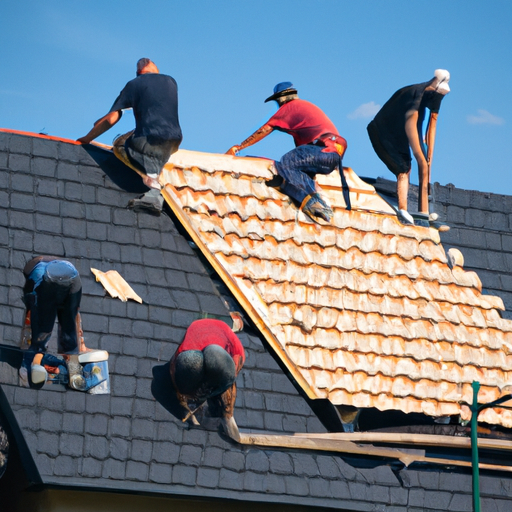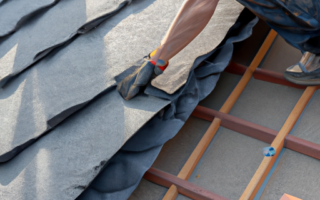Choosing the Right Roofing Material: A Guide to the Top Factors to Consider
Choosing the right roofing material for your construction project is a crucial decision that can have a significant impact on the overall durability, aesthetics, and energy efficiency of your roof. With a wide array of options available in the market, it becomes important to consider several key factors before making a final decision.
One of the top factors to consider when choosing a roofing material is the climate of your location. Different roofing materials perform better in certain climates than others. For example, metal roofs are highly durable and can withstand extreme weather conditions, making them a great option for areas with high winds or heavy snowfall. On the other hand, clay or concrete tiles are ideal for hot and sunny climates as they offer excellent heat resistance.
The slope or pitch of your roof is another important factor to consider. Some roofing materials, such as asphalt shingles, work well on roofs with a steep pitch, while others, like rubber or PVC, are better suited for low-slope roofs. The pitch of your roof will affect the shedding of water and debris, so it’s essential to select a material that is compatible with the slope of your roof.
Cost is also a crucial factor to consider when choosing a roofing material. The upfront cost, installation expenses, and long-term maintenance requirements can vary significantly between different materials. While asphalt shingles and metal roofs are relatively affordable options, they may require more frequent repairs or replacements compared to more durable materials like slate or copper.
Additionally, consider the lifespan and durability of the roofing material. Some materials, like slate or metal, can last for several decades, while others may have a shorter lifespan. It’s important to assess the longevity and maintenance needs of each material to determine which one offers the best value for your investment.
Finally, don’t overlook the aesthetic aspect of the roofing material. The appearance of your roof can greatly impact the overall curb appeal of your property. Take into account the architectural style of your home and choose a roofing material that complements it. Whether you prefer the classic look of traditional asphalt shingles or the rustic charm of wooden shakes, make sure the material enhances the overall aesthetics of your property.
Choosing the right roofing material requires careful consideration of several important factors. By taking into account your climate, roof slope, cost, lifespan, and aesthetic preferences, you can select a material that will not only protect your property but also enhance its overall value and appeal.
Structural Integrity: Key Considerations for a Sturdy and Long-Lasting Roof
When it comes to roof construction, ensuring the structural integrity of the roof is paramount. A sturdy and long-lasting roof not only safeguards the entire building but also provides protection from harsh weather conditions.
Here are some key considerations for achieving a structurally sound roof:
1. Proper Design and Planning: The first step in constructing a strong roof is to have a well-thought-out design and a meticulous plan. This includes appropriate slope calculations, load-bearing capacity assessments, and consideration of local building codes and regulations. Engaging the services of a professional architect or structural engineer is highly recommended.
2. Quality Materials: The choice of roofing materials plays a crucial role in ensuring the longevity and strength of the roof. Opt for high-quality materials that are durable, weather-resistant, and have a proven track record. This may include options such as asphalt shingles, metal tiles, or concrete roof tiles, depending on the specific requirements of the building.
3. Adequate Roof Support: The roof’s support structure, such as trusses, rafters, and beams, should be designed and installed based on load calculations and engineering standards. A properly designed support system will distribute the weight evenly and prevent sagging or collapse under heavy loads, such as snow accumulation.
4. Solid Roof Decking: The roof decking provides a solid foundation for the roofing materials and contributes to the overall structural integrity of the roof. It should be made of sturdy materials, such as plywood or oriented strand board (OSB), and installed correctly to ensure a secure attachment to the roof’s support structure.
5. Proper Ventilation: Adequate ventilation is essential for maintaining a healthy roof system. Proper airflow helps prevent moisture buildup, which can lead to mold, rot, and other issues. Properly designed vents and ventilation systems should be incorporated into the roof construction plan.
6. Professional Installation: Hiring qualified and experienced roofing contractors is crucial for the success of any roof construction project. They have the expertise to ensure that all the components are installed correctly, following industry best practices and local building codes.
7. Regular Maintenance: Once the roof is constructed, regular maintenance is necessary to ensure its prolonged life and structural integrity. This includes regular inspections, cleaning of debris, and prompt repairs of any damage or leaks.
In conclusion, constructing a structurally sound and long-lasting roof requires careful planning, the use of quality materials, proper installation, and regular maintenance. By considering these factors, building owners can enjoy the benefits of a sturdy and reliable roof that can withstand the test of time and protect their investment.
Energy Efficiency in Roof Construction: Factors to Optimize Thermal Performance
Energy efficiency in roof construction is an essential consideration for any homeowner or building owner. With the increasing emphasis on sustainable and eco-friendly solutions, optimizing the thermal performance of your roof can not only help you save on energy costs but also reduce your carbon footprint.
There are several factors that play a crucial role in enhancing the energy efficiency of a roof. First and foremost, the choice of insulation material is critical. Utilizing insulation with a high R-value can effectively prevent heat loss during the colder months and minimize heat gain during the hot summer months. Common insulation materials include fiberglass, cellulose, and rigid foam boards.
In addition to insulation, proper ventilation is another key factor in optimizing the thermal performance of a roof. Adequate airflow helps to regulate the temperature and moisture levels in the attic or roof space. This prevents the formation of condensation, which can lead to mold growth and structural damage over time. Roof vents, ridge vents, and soffit vents are commonly used to facilitate the movement of air.
Moreover, the color and reflectivity of the roofing material can significantly impact the energy efficiency of a roof. Light-colored or reflective roofing materials, often referred to as cool roofs, have a higher solar reflectance and emit a larger portion of absorbed solar radiation. This reduces heat transfer to the building, keeping the interior cooler and decreasing the demand for air conditioning.
Proper sealing and weatherization of the roof are essential to prevent air leaks and thermal bridging. Gaps or cracks in the roof structure can lead to heat loss or gain, undermining the insulation’s effectiveness. Using high-quality sealants and ensuring a tight seal around penetrations, such as pipes or chimneys, can help maintain an airtight barrier and improve energy efficiency.
Lastly, considering the orientation and design of the roof can also contribute to its energy efficiency. For example, incorporating roof overhangs or shading devices can minimize direct sunlight exposure and reduce heat gain. Working with an architect or designer who specializes in energy-efficient design can help you optimize your roof’s orientation and layout to maximize solar gain or minimize it, depending on your specific climate and goals.
When it comes to energy efficiency in roof construction, it is crucial to consider insulation, ventilation, roofing material reflectivity, sealing, and design. By carefully addressing these factors, you can create a more energy-efficient roof that not only provides comfort but also helps protect the environment.
Budgeting and Cost Factors in Roofing Projects: A Comprehensive Overview
When it comes to roof construction, budgeting and cost factors play a crucial role in determining the feasibility and success of a project. With numerous materials, designs, and labor costs involved, it is important to carefully consider these factors before embarking on any roofing project. In this comprehensive overview, we will discuss the top budgeting and cost factors that need to be considered in roof construction.
One of the main cost factors in roof construction is the choice of materials. Different roofing materials vary greatly in terms of cost, durability, and maintenance requirements. Factors such as the climate of the area, the expected lifespan of the roof, and the overall aesthetic appeal should be taken into account when selecting the materials. Common roofing materials include asphalt shingles, metal, tiles, and wood shakes, each with its own cost implications.
Another crucial consideration in budgeting for roof construction is the size and complexity of the project. Larger roofs or those with intricate designs will generally require more materials, labor, and time, thus increasing the overall cost. It is important to accurately estimate the size and complexity of the project to avoid unexpected expenses and delays.
Labor costs are another significant factor to consider. The expertise, experience, and reputation of the roofing contractor or company will largely influence the labor costs involved. It is important to obtain multiple quotes, check references, and clarify the scope of work before finalizing any agreements. Additionally, remember to inquire about any potential additional costs such as debris removal or repairs to ensure an accurate estimation of the total project cost.
Furthermore, the condition of the existing roof, if applicable, can also impact the overall project cost. If extensive repairs or removal of the existing roof is required, it will add to the total expenses. Inspections should be conducted by professionals to assess the condition of the current roof and to accurately determine the necessary repairs or replacements.
Lastly, it is crucial to consider any additional costs that may arise during the project. Unforeseen issues such as structural damage, pest infestations, or the need for additional insulation can significantly impact the budget. Setting aside a contingency fund is highly recommended to account for such unforeseen expenses.
In conclusion, budgeting and cost factors are essential considerations in roof construction. Carefully selecting the materials, accurately estimating the size and complexity of the project, evaluating labor costs, assessing the condition of the existing roof, and accounting for any potential additional expenses are all critical in ensuring the success of the roofing project. By considering these factors in advance, individuals can make informed decisions and achieve a well-constructed roof within their budget constraints.



